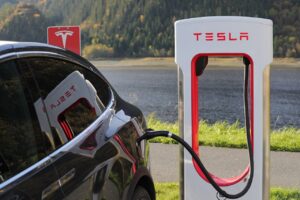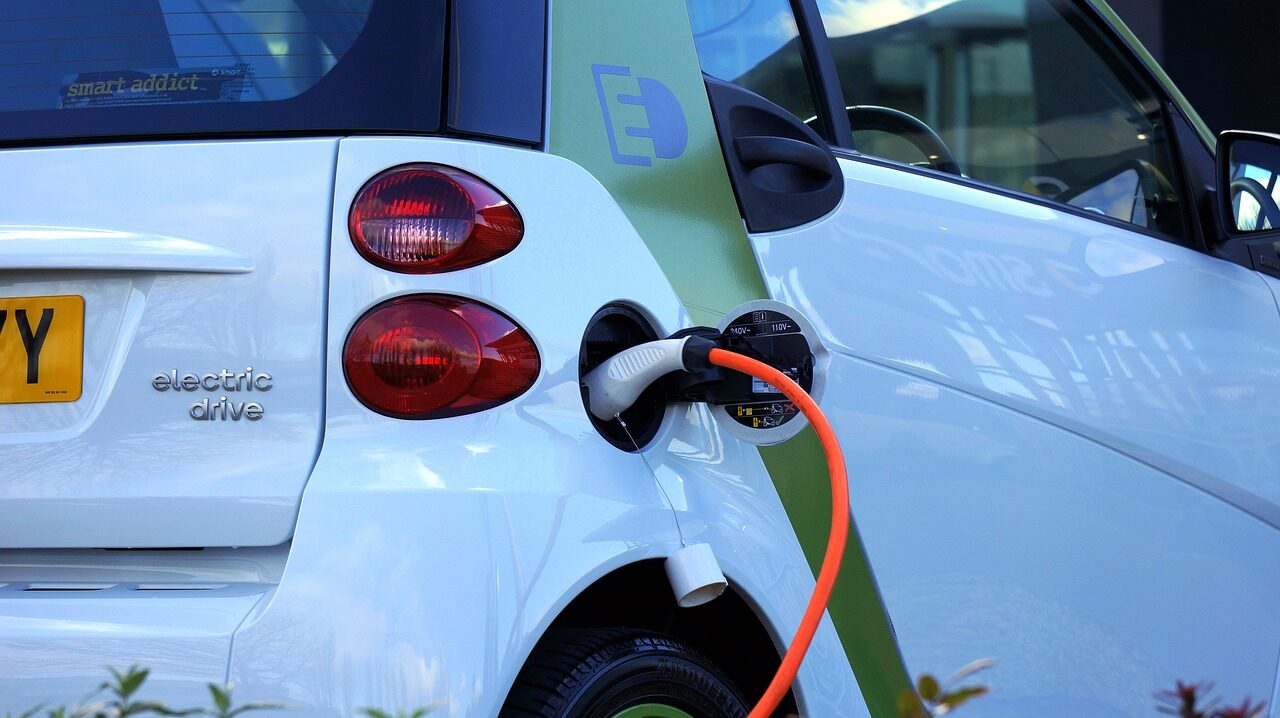A friend recently told me of a new study showing that the “life cycle” of electric vehicles (EVs) causes fewer CO2 emissions than gas-powered cars. This is important since research comparing greenhouse gas (GHG) emissions per mile have left out the enormous emissions associated with the complex mining, manufacturing and disposal phases of EVs. Is this recent announcement just more corporate bunk? Or, could it mean that EVs are truly a step toward a greener world?
And, is there a transportation alternative that avoids the pitfalls of both EVs and gas cars?
The article by Julian Spector and Dan McCarthy was highly touted as showing that EVs are “definitely cleaner than gas cars over their lifetime.” Citing research by BloombergNEF it admitted that the battery production phase of EVs results in more carbon emissions than than occurs with fossil fuel (FF) cars. It claimed that driving EVs (the use phase) is so much “cleaner” than gas cars that, overall, EVs are responsible for fewer GHGs. It further insisted that the production phase of EVs is getting cleaner all the time, meaning that it is “a slam-dunk” for the environment.
Ever since I began teaching Environmental Psychology at Washington University years ago, when EVs were barely on the horizon, I explained to students the sleight-of-hand that manufacturers made when claiming that newer FF cars emitted fewer GHGs than older models. How could it be that cars were getting “cleaner” while simultaneously GHGs from all cars were going up?
This occurs if the categories of cars being purchased changes. More and more SUVs were being sold and they emitted greater quantities of CO2 than did sedans. Thus, sedans became “cleaner;” SUVs became “cleaner;” but the total quantity of CO2 from cars went up. The same principle applies today with FF cars and EVs.
Ralph Nader, who gained notoriety from publishing Unsafe at Any Speed (1965), recently wrote of serious problems with EVs. These include high-voltage lithium-ion battery fires, disruption of electric power by storms, the scarcity of minerals required for manufacture, and serious difficulties with recycling their very heavy batteries,
Car categories also affects pollution from tiny tire particles. While tire manufacturers are slowly “moving to make-longer lasting tires,” the category of EVs presents a greater problem than gas cars.
When a FF car weighing 5000 pounds is replaced by an EV version, the weight is 8000 pounds. As weight goes up, tire duration goes way down. Due to their heavier weight, EVs get only 13,000 miles per tire instead of the expected 40,000 miles.
When the Rubber Hits the Road
Writing in The Atlantic, David Zipper probes deeply into the tire problem that Nader touched on. Tire toxins include rubber, petroleum, nylon, and steel, with many specks being so minuscule that they cannot be seen by the human eye. Their quantity of 6 million tons globally is likely growing due to the heavier weight of EVs. Smooth roads can actually be more harmful because they result in smaller particles that float further.
The weight of EVs increases health threats to humans and other living things. Tires could be the source of 28% of ocean microplastics. One study found that the chemical 6PPD (designed to lengthen tire life) caused Northwestern-coho-salmon populations to decline dramatically.
Low income neighborhoods next to highways have suffered elevated birth defects, kidney damage and problems for respiratory and neurological systems. The extra weight of EVs render them more dangerous to bikers, pedestrians and those in other cars.
One factor which makes EVs so attractive is their extra power. The power appears both for acceleration (“instant torque”) and “regenerative” braking. These increase tire friction, which releases more wee particles that poison.
Since transportation is a large portion of total energy used, EVs are an integral part of the drive to “electrify everything.” Canada is offering $13 billion to help Volkswagen build a facility to manufacture EV batteries. The “1500 acres of prime agricultural land” that would be taken for that factory is merely a fraction of the amount of expanding land required for expanding electrification of energy sources.
While we usually think of ways to obtain necessary minerals for electrical power from mining land, there is likely to be at least as destructive effects from deep sea mining. Thousands of feet at the bottom of the sea rest nodules, deposits and crusts containing materials such as nickel, rare earths, and cobalt.
The deep sea mining process releases chemicals and heavy metals which disrupt marine life. Sediments from mining are typically dumped back into the sea “which can harm filter-feeding species like corals and sponges.” The bottom of deep oceans are devoid of light and sound and typically do not have disturbances that stir up sediment. Many organisms on seabeds evolved without ways to filter out clouds of dirt or respond to the shining lights or noises of machines searching for and extracting minerals. Effects on unknown species are, of course, unknown.
Environmental Disaster Manifests Social Disruption
It is no coincidence that the production of EVs is wrapped around some of the most loathsome social conflicts on Earth. Unlimited expansion of electrification requires obfuscating what lurks in its corners.

Far from being tangential for the environment, these events establish the context of Musk’s most revealing statement, “We will coup whoever we want.” Bolivia has extremely rich deposits of lithium which can most efficiently be mined for EV batteries by extracting vast amounts of water from an already dry desert.
When Bolivian president Evo Morales sought deals that would bring more more money to the poor of that country he was illegally removed from office in 2019. When Musk scripted that infamous comment in July 2020, his company had long looked at Bolivia with an eye hungry for lower lithium prices.
Even more distressing are the horrors that confront cobalt workers, as documented by Siddharth Kara’s Cobalt Red: How the Blood of the Congo Powers Our Lives (2023). Almost 75% of cobalt is currently mined in the DRC by being “dug by ‘artisanal miners’, namely desperately poor people, including many children, for pennies a day.”
In 2023 flooding and ensuing armed violence forced a half a million Congolese from their homes. Corporate media was not exactly absorbed with the story. As Secretary General of the Norwegian Refugee Council Jan Egeland told Amy Goodman on Democracy Now! “The Congo is not ignored by those who want to extract the riches of that place. It’s ignored by the rest of the world who would want to come to the relief of the children and families of the Congo.”
These practices portend things to come. As mining expands to the far corners on Earth, minerals required for solar panels, wind mills and EVs will become increasing difficult to find and, like fossil fuel, will have decreasing yields. Corporations will increasingly treat indigenous communities as obstacles to be shoved aside and their politicians will increasingly comply “just to deal with the energy crisis we have right now.”
When dollar costs of manufacturing cars are reported, some of these factors might not make their way to corporate spreadsheets:
- Legal donations to elect favorable politicians;
- Illegal bribes for politicians;
- Propaganda telling affected communities that there will be no serious environmental consequences from mining and manufacturing;
- Lawsuits from communities that suffer serious environmental consequences;
- Police and military personnel and equipment costs to put down opposition;
- Funeral costs for those killed by police and military.
Since EV supply chains require such a vast number of different minerals, these costs could well exceed those for FF cars.
The Only Green Form of Transportation Is …
In reality, neither gas cars nor EVs sport the greenest transportation. The green alternative has been known for decades. Actually, for centuries or millennia. Just google the phrase “walkable communities” and you will find thousands of articles exploring how people can live better with parks, restaurants, stores, post offices, barber shops, schools, clinics, etc. within walkable distances.
Unfortunately, if discussions of transportation even mention “walkable communities” it is a throw-away phrase to be ignored after giving it lip service. The debate over EVs vs. gas cars is an enormous diversion from grappling with genuine issues that confront efforts to reduce transportation impacts:
- How do we transform existing neighborhoods into walkable/cyclable ones while including the very young, very old and very sick?
- How do we maximize closeness to work while minimizing difficulties with moving?
- What would be the most reasonable ration of transportation miles per person via bus, train and air?
Questions such as these show appreciation of this truism: The only green transportation is less transportation. We may take buses or trains for some trips and cars for special trips but green transportation has the goal of minimizing trips that cannot be made by walking of cycling (or golf-carting for those with physical limitations).

EVs epitomize the mindset of conspicuous consumption. As General Motors CEO Mary Barra quipped: “Once you’ve experienced an [electric vehicle] and all it has to offer—the torque, handling, performance, capability—you’re in.” If the glorification of crass consumerism by corporate executives is repulsive, its regurgitation by “environmentalists” is obscene.
Those who adopt the corporate mentality have their own set of questions:
- Why build a home with passivhaus design when you can cover the top of a neighboring mountain with wind turbines?
- Wouldn’t it be a waste of effort to require new homes to be built to passivhaus standards when the tops of a mountain range could be clearcut for cheap, clean energy from an expanding wind turbine company?
- Why pass legislation to enhance walkable communities when EVs run so quietly and can zoom from 0 to 60 mph in less than four seconds?
- Why would those people badmouth EVs when buying one gives me warm fuzzy feelings that I have done all that I need to do for the environment?
EVs are hardly the only commodity that saddle humanity and the Earth with negative effects. At the same time that cars have increased in size and ostentation, home building has marched in step to the tune of pointless growth. As Canadian author Eves Engler observes, it’s “past time to shift away from the private car and resource intensive sprawl towards walkable, bikeable and transit-oriented living spaces … automotive infrastructure underpins a massive growth in house sizes, which consume more wood, cement,” glass pipe, etc.
The drive toward “more stuff” is not limited to larger stuff. It also means stuff that falls apart or goes out of style quicker. You may have noticed a shorter life-use span for everything from clothes to electric coffee pots along with the increasing inability to repair consumer products.
Those in Bolivia and the Congo who have direct experience with Western greed for power are not alone. For people throughout the world who suffer from fossil fuel colonialism, electrification of energy is not the end-all-be-all of a “just transition” to a more humane economy. Electrification is already becoming electric colonialism.
The deep green question regarding EVs is: “Should there be an EV for every adult on Earth?” If the answer is “yes,” then EVs could be even more destructive than FF cars because of the vast amount of habitat required for mineral extraction as well as the expanded use of FFs that would be required to produce them. If the answer is “no” then applauding EVs manufactured for only the rich world is the most crass form of colonialism imaginable.
Imaginary Numbers and Imagining True Effects
The electrification of energy should go global only if it is by and for those where the transition occurs. The means self-determination of energy sources that are consistent with people’s culture, preserve the land, water and air where they live, and do not sacrifice these on the alter of corporate profit.
Infinite economic growth is antithetical to cultural and environmental preservation. Tunnel-visioning on the very real threat of climate change has lured many an environmentalist into the trap of “green growth” and away from the pursuit of conservation.
As Stan Cox points out, “economic growth has never been achieved over large geographical areas for extended time periods without having serious environmental impacts.” He explains that even a 2% growth rate cannot be sustained “without excessive resource extraction and greenhouse-gas emissions.”
Keeping these nuances in minds shines light on the claim that the life cycle of EVs has fewer CO2 emissions than gas cars. A fact that is superficially true can be rendered ambiguous or false when taking its context into account.
A more complete context for cars would go beyond “life cycle” and incorporate its “Total Life Effects” (TLE), which would include factors which might only be imagined. The idea of imaginary values has stuck with me ever since taking high school algebra and studying little “i,” the square root of -1, or -1½.
A complex number is expressed as: a + i X b, where a = a real number and b = the multiple for the imaginary number. “i” has become a serious line of study of abstract math. (Ironically, a field which finds “i” particularly useful is electricity.)
Since many enormous environmental effects are incalculable, big “I” could be included to imagine them. It is difficult to assess total environmental effects of the extinction of a species on its ecosystem. How would anyone estimate financial effects of the collapse of an ecosystem on near and far ecosystems? Who could possibly calculate the effects of an underwater holocaust of unknown species brought on by deep sea mining for minerals essential for EVs?
Thus, TLS would be expressed as a complex number with big I being Incalculable effects and Σ being their total effect: TLE = $ + Σ I
All hitherto formulas for calculating environmental effects of manufacturing and mining are invalid and can become valid only by including big “I”s, that it, all potential effects on all species, including human cultures. In other words, those who who pretend that infinite expansion of electricity has no effect and leave big “I” out of their calculations – just as those who dismiss little “i” – suffer from a profound deficit in imagination.

